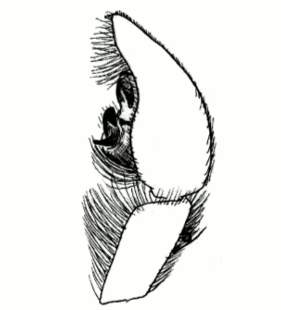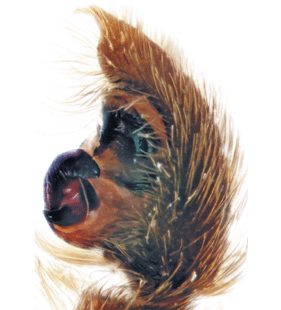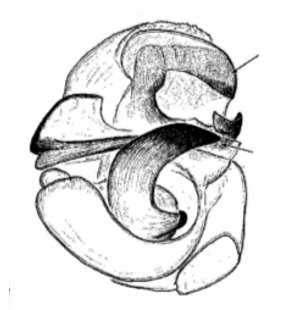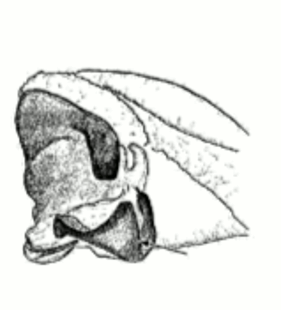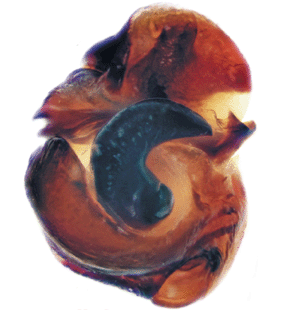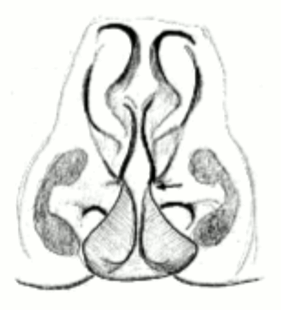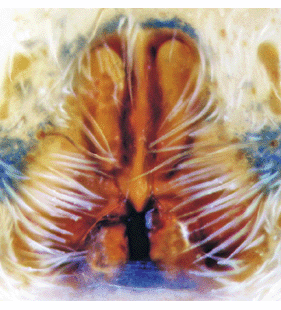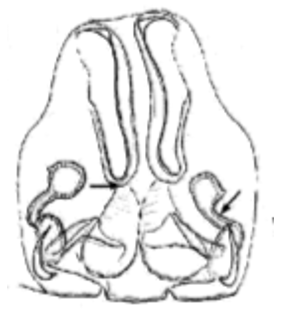Pardosa azerifalcata Marusik, Guseinov & Koponen, 2003
Beschreibung
Männchen
Schwarzes Cymbium mit schwarzen Setae besetzt. Tegularapophyse groß und mit zwei gut entwickelten Armen. Embolusbasis weit, zweifach durch eine Furche unterteilt, Embolusspitze schwach gebogen. Terminalapophyse zweifach geteilt: ein großer schnabelförmiger Teil und ein kleiner. Palea mit charakteristischem Kamm. Paleaform, Terminalapophyse, Tegularapophyse und Embolus spezifisch. Basaler Embolusteil sehr dünn und Embolus gekrümmt.
Körpefärbung dunkel. Prosomaschild 3.0-3.4 mm lang und 2.3-2.5 mm breit, dunkelbraun, Augenfeld schwarz, gelb-braunes Band nur im Thoraxteil distinkt, Seitenstreifen unterbrochen. Cheliceren dunkelbraun. Sternum, Labium und Gnathocoxen grau. Sternum mit hellem Fleck im vorderen Bereich.
Beine hellgelb mit hellgrauen Flecken. Metatarsus mit vier ventralen Stacheln; Metatarsi I-II mit zwei retrolateralen Stacheln.
Dorsum grau, mit wenigen kleinen hellen Flecken, Venter gelb mit grauem vorderen Bereich.
Körperlänge Männchen: 5.5-5.6 mmWeibchen
Epigynenseptum lang und dünn, sein vorderer Teil lang, Receptaculae dünn. Breite des basalen Septumteils (freier Teil) entspricht der Breite des Septumstammes. Taschen unberührt, Fovea teilweise sichtbar.
Prosomaschild 3.4-3.5 mm lang, 2.6-2.8 mm breit, medianes Band heller und breiter als im Männchen, helle Seitenstreifen erreichen den Kopfbereich. Sternum mit dicht stehenden hellen Setae und Medianband entlang fast des ganzen sternums. Gnathocoxen und Cheliceren gelb.
Beinbestachelung wie im Männchen, Annulierung distinkter und dunkler als im Männchen.
Dorsumzeichnung bestehend aus größeren und distinkteren gelben Flecken als im Männchen. Venter hellgrau.
Körperlänge Weibchen: 8.3 mmZusätzliche Informationen
Schwesterart von P. jergeniensis.
Verbreitung
Phänologie
| Jan | Feb | Mar | Apr | May | Jun | Jul | Aug | Sep | Oct | Nov | Dec |
 |  |
Abbildungen
Verbreitungsnachweise
"No reference" bedeutet nicht, dass die Art in diesem Land nicht vorkommt, sondern dass wir die Referenz hierfür noch nicht eingefügt haben. Wir arbeiten daran.
Literatur
Marusik Y M, Guseinov E F, Koponen S (2003a) A survey of east Palaearctic Lycosidae (Araneae). I. On three closely related species of the Pardosa falcata-group. Acta Arachnologica 52: 43-50 ![]()
Otto S (2022) Caucasian spiders. A faunistic database on the spiders of the Caucasus Ecoregion. Database version 02.2022. Internet: caucasus-spiders.info.
WSC (2025) World Spider Catalog. Version 26. Natural History Museum Bern, online at http://wsc.nmbe.ch (28.2.2025) doi: 10.24436/2 ![]()
Zamani A, Nadolny A A, Esyunin S L, Marusik Y M (2022a) New data on the spider fauna of Iran (Arachnida: Araneae), part IX. Arachnology 19: 358-384 ![]()
